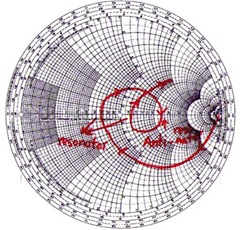


Here ‘Y’ corresponds to load admittance and ‘Z’ corresponds to impedance. The equation which represents the relation between these two factors (impedance and admittance) is: To do this, one has to clearly analyze the antenna admittance instead of impedance and simply summate all those. As we all are aware that admittance has revere relation to impedance, this admittance chart works well for complicated parallel scenarios. So, to minimize the complications involved in impedance charts, these admittance charts were developed. Whereas the tricky part here is mathematical calculation when dealing with parallel elements where the elements are of inductors, transmission lines, and capacitors.
Antenna smith chart series#
The impedance chart is crucially implemented when working on series loads, all the functionality here is to summate the whole increased impedances. The picture representing impedance smith chart is shown below: Impedance Smith Chart Admittance Smith Chart This impedance of these are the main type where other types are considered as its derivatives. These are generally termed as the usual type of smith charts as they correspond to impedance and functions in an excellent way even with huge loads constructed of many series components where these are the crucial components in the impedance matching and for other RF corresponding operations. Smith charts are plotted in two dimensions on the intricate reflection coefficient plane and the chart is generally standardized in impedance or admittance or even both through multiple colors in order to differentiate between those parameters and depending on this scaling, these are primarily categorized as three types. This because most RF circuit software’s consists of smith charts for displaying results. As it was known that usage of the smith chart for resolving complicated mathematical problems impose matching issues, but it is still an effective method in explaining how RF frequencies perform at multiple frequency levels. The chart will be more common in use internal to the regions that have a radius range of 1 or < 1 such as in the cases of stability performance and oscillator design. At the same time, the device is also used to display various factors like admittance, continual gain outlines, impedance, stability, noise figure, and also shows a detailed analysis of mechanical vibrations. Smith chart is considered as a graphical measuring tool which is constructed mainly for electrical engineers to solve problems related to RF transmission lines and matching devices.


 0 kommentar(er)
0 kommentar(er)
